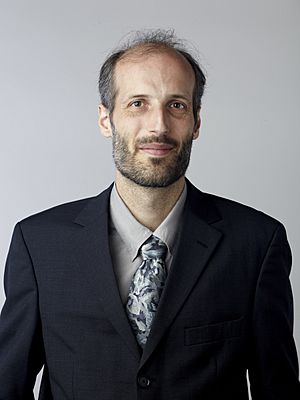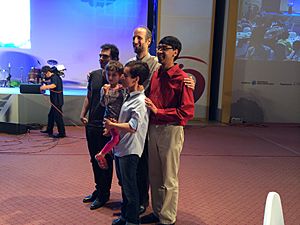Martin Hairer facts for kids
Quick facts for kids
Sir Martin Hairer
|
|
|---|---|

Hairer in 2014
|
|
| Born | 14 November 1975 Geneva, Switzerland
|
| Citizenship |
|
| Education | University of Geneva |
| Spouse(s) |
Xue-Mei Li
(m. 2003) |
| Awards |
|
| Scientific career | |
| Fields | |
| Institutions | École Polytechnique Fédérale de Lausanne Imperial College London University of Warwick New York University |
| Thesis | Comportement Asymptotique d'Équations à Dérivées Partielles Stochastiques (2001) |
| Doctoral advisor | Jean-Pierre Eckmann |
Sir Martin Hairer (born November 14, 1975) is a famous mathematician from Austria and Britain. He works on a special kind of math called stochastic analysis. This field helps understand things that change randomly over time. He is a professor at EPFL in Switzerland and at Imperial College London in the UK. He also taught at the University of Warwick and New York University. In 2014, he received the Fields Medal, which is one of the highest awards a mathematician can get. He also won the Breakthrough Prize in Mathematics in 2021.
Contents
Early Life and Education
Martin Hairer was born in Geneva, Switzerland. He went to high school there and finished in 1994. While in school, he created software for editing sounds. This software, called Amadeus, became very popular. He even kept working on it while studying at university.
He then went to the University of Geneva. He earned his Bachelor's degree in Mathematics in 1998. Later that year, he also got a Master's degree in Physics. In 2001, he completed his PhD in Physics. His main teacher for his PhD was Jean-Pierre Eckmann.
What Martin Hairer Studies
Professor Hairer is known for his work on stochastic partial differential equations. These are complex math problems that help describe systems that have random changes. For example, they can be used to model how heat spreads in a material if there's some randomness involved.
He has also worked on several other important math ideas. These include understanding how random systems behave over a long time. He also developed a new way to study very complex math problems, which he called "regularity structures." This new method helped him solve problems that other mathematicians found very difficult.
Besides his math research, he also develops computer software. His company, HairerSoft, creates programs for Macintosh computers.
Awards and Special Recognitions
Martin Hairer has received many important awards for his math work. These awards show how much his contributions have helped the world of mathematics.
- In 2008, he won the Whitehead Prize and the Philip Leverhulme Prize.
- He became a Fellow of the Royal Society in 2014. This is a very respected group of scientists in the UK.
- Also in 2014, he received the Fermat Prize and the Fröhlich Prize.
- The most famous award he received was the Fields Medal in 2014. This medal is given every four years to mathematicians under 40. It's like the Nobel Prize for math!
- In 2016, he was made an Honorary Knight Commander of the Order of the British Empire by the Queen of England. This means he can be called "Sir Martin Hairer."
- He won the Breakthrough Prize in Mathematics in 2021.
- In 2022, he received the King Faisal Prize.

Personal Life
Sir Martin Hairer has both Austrian and British citizenship. He can speak French, German, and English. In 2003, he married another mathematician named Li Xue-Mei. His father, Ernst Hairer, is also a mathematician at the University of Geneva.

